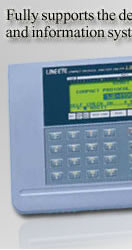
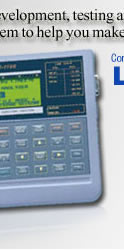
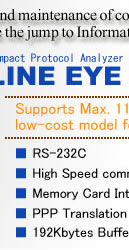
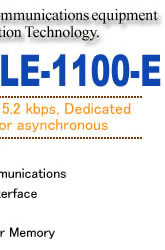
Asynchronous is possible to be monitored up to a
max. 115.2 kbps in real-time. PPP(Point-to-Point Protocol),
which can be monitored, is frequently used for the internet
connection between a PC and a modem . High-performance
communications analyzers are capable of monitoring, simulation
and BERT. Not only RS-232C of a standard interface but also
expandability supports RS-422/485, X.21, V.35, current loop
TTL and IrDA with option adapters.
Monitoring
Supports Max. 115.2 kbps
of Communication
| Asynchronous
communication is possible up to a max. 115.2 kbps.
Separate speeds can be set for transmission and
reception. |
 |
Analysis of Interface
Signal Line
 |
2-color LEDs indicate (red-green-out)
signal high/low level and disconnection, making it easy
to confirm cables are connected. Also, using a delay
time feature, the change of individual signal lines can
be measured in 0.1ms
resolutions. |
Time Stamp and Idle Time
Measurement
The data and time of transmission/reception are recorded
on data frames. Then, using an auto run-stop feature with
which the user specifies measurement start and end time,
measurements can be performed unmanned and the time of errors
easily and comfortably checked later. LE-1100-E can also
measure the amount of idle time between communications frames
and closely monitor transmission/ reception response and
communications timeout status
Protocol Translation
Display
| Each protocol of BSC and PPP is
translated and displayed. One-touch switching makes
analysis or observation speed up. |
< PPP translation display
> |
 |
Large 192KB Memory
Buffer
Incorporates a large memory buffer for long-term
measurement. Other features include a convenient two-dividing
ring buffer for comparing data and protection to safeguard
data against misoperation or mishandling
Trigger
Feature
First of all, two actions will be set up to four pairs.
One of them is the action of trigger conditions. The other the
followings will be able to performed under the conditions of
specific data string receipt (Max. eight characters), error
occurrences, interface signal line changes and etc; automatic
stop of monitoring, timer/counter control and etc.
Moreover, the timer/counter function with the trigger
function allows you to be able to measure specific data, the
number of error occurrence, and response time from
transmission and reception sequence. As a result of that, the
clarification of intermittent troubles will be performed
effectively.
Auto-Configuration
Auto-configuration can be analyzed and set such as baud
rate and data framing automatically set based on findings.
This is effective for monitoring lines of unknown
communications conditions.
Simulations
Four Kinds of Simulation
Functions
| [ MANUAL mode
] |
| The manual mode helps you send the data registered
in transmission table which corresponds to the "0" to
"F" keys. The data can be sent with the press of a key.
While checking replies from a unit under development
with the monitoring feature of LE series, you can easily
and simply test the communications process. You can also
send fixed data by registering it under a key
combination of the SHIFT and "0" to "D" keys, as well as
turn RS and ER signal lines on/off with the SHIFT and
"E"/"F" key combinations. |
| |
| [ MATCH mode
] |
| In the MATCH mode, when "SEND" is selected as the
trigger action and that condition is satisfied,
registered data can be sent after a set amount of reply
time elapses. By triggering a reply transmission with a
specific type of data or error as the trigger condition,
timeout processing and error response operations can be
easily checked. |
| |
| [ FLOW mode
] |
| Flow control can be simulated on the transmission
and reception-lines using X-on/off flow control or the
control line handshake. |
| |
| [ ECHO mode
] |
| In the ECHO mode, LE-1100-E internally returns
received data in units of bits, bytes or frames
(character string). It is used to test display terminals
and communications terminals, and to set loopback points
for the BERT feature. |
| |
Transmission Tables of
8K Data
With a dedicated editor that enables copying, pasting,
filling and capturing of sixteen types of transmission data,
data can be registered in transmission tables and used in the
various modes.
BERT(Bit Error Rate
Test)
Max. 115.2kbps
BERT
| As a standard feature, LE-1100-E comes
with a ITU-T G.821-conforming BERT feature. It allows
you to evaluate communication quality and identify fault
points on communications lines, including modern and
terminal adapters in loopback tests and comparison tests
using a simulated random pattern. It provides
capabilities comparable to purpose-specific hardware,
such as bit error interrupts by key operation, long
continuous measurement as well as measurement results
print out and electronic output. |
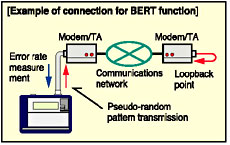 |
Packed with Easy to Use Handy
Features
Menu-based Simple
Operation
Functions are easily selected from menus.
Off-line Analysis with
Searching and
Counting
| Any range of data saved in the buffer can
be scrolled, paged and displayed in units of one
character, one line or one page. Also, a formidable
search engine makes it possible to search for specific
data, errors, time stamps, etc. And, it tells you how
many of the search items are found in the buffer. |
 |
Built-in Memory Card
Interface
A memory card can be used in two modes; a file mode and a
buffer mode. In the file mode, it is capable of storing up to
100 files of setting information or monitored data. Since the
saved data can be recorded, it is possible to be used more
effectively; the date, time and the file name. In the buffer
mode, it expands the capacity of the buffer memory.
Data
Printing
Users can print out measurement data of a user-specified
range in a continuous format. And, with a dedicated printer,
it is possible to make hard copies of windows® just as they
appear on the display.
Superb
Extensibility
The use of optional interface adapters allows you to
correspond to the various interface except RS-232C (V.24),
which makes the rich functions of LE-1100-E much greater
Powerful External
Interface Functions
 |
Data is displayed on a large LCD and
simultaneously stored in memory in real-time. And, still
at the same time, the same data can be output via the
AUX port to an external device such as a PC, all while
monitoring is in progress.
(Need to use of optional
PC software <LE-PC200-E>) |









